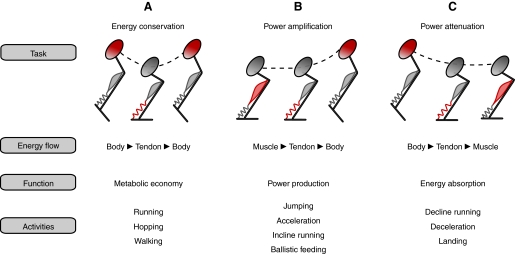Fig. 1.
A schematic illustrating how the directional flow of energy in muscle–tendon systems determines mechanical function. (A) Mechanical energy is conserved (i.e. muscle work is reduced) when elastic structures store and recover cyclic changes in the mechanical energy of the body or an appendage. (B) Tendons loaded directly by the work of muscle contraction can release that energy rapidly to the body. If the energy is released more rapidly than it is stored, muscle power can be amplified. (C) A rapid decline in the mechanical energy of the body or an appendage can be temporarily stored as elastic strain energy, followed by the release of this strain energy to do work on active muscles. This mechanism has the potential to reduce peak power input to muscles, thereby functioning as a power attenuator. In the figure, red indicates the flow of energy between active muscle contraction, tendon strain energy and body kinetic/potential energies.

